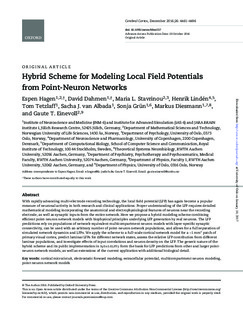| dc.contributor.author | Hagen, Espen | |
| dc.contributor.author | Dahmen, David | |
| dc.contributor.author | Stavrinou, Maria | |
| dc.contributor.author | Linden, Henrik | |
| dc.contributor.author | Tetzlaff, Tom | |
| dc.contributor.author | Van Albada, Sacha | |
| dc.contributor.author | Gruen, Sonja | |
| dc.contributor.author | Diesmann, Markus | |
| dc.contributor.author | Einevoll, Gaute | |
| dc.date.accessioned | 2018-01-02T10:07:39Z | |
| dc.date.available | 2018-01-02T10:07:39Z | |
| dc.date.created | 2016-11-12T00:33:53Z | |
| dc.date.issued | 2016 | |
| dc.identifier.citation | Cerebral Cortex. 2016, 26 (12), 4461-4496. | nb_NO |
| dc.identifier.issn | 1047-3211 | |
| dc.identifier.uri | http://hdl.handle.net/11250/2473924 | |
| dc.description.abstract | With rapidly advancing multi-electrode recording technology, the local field potential (LFP) has again become a popular measure of neuronal activity in both research and clinical applications. Proper understanding of the LFP requires detailed mathematical modeling incorporating the anatomical and electrophysiological features of neurons near the recording electrode, as well as synaptic inputs from the entire network. Here we propose a hybrid modeling scheme combining efficient point-neuron network models with biophysical principles underlying LFP generation by real neurons. The LFP predictions rely on populations of network-equivalent multicompartment neuron models with layer-specific synaptic connectivity, can be used with an arbitrary number of point-neuron network populations, and allows for a full separation of simulated network dynamics and LFPs. We apply the scheme to a full-scale cortical network model for a ∼1 mm2 patch of primary visual cortex, predict laminar LFPs for different network states, assess the relative LFP contribution from different laminar populations, and investigate effects of input correlations and neuron density on the LFP. The generic nature of the hybrid scheme and its public implementation in hybridLFPy form the basis for LFP predictions from other and larger point-neuron network models, as well as extensions of the current application with additional biological detail. | nb_NO |
| dc.language.iso | eng | nb_NO |
| dc.relation.uri | http://cercor.oxfordjournals.org/content/early/2016/10/20/cercor.bhw237.full | |
| dc.rights | Attribution-NonCommercial-NoDerivatives 4.0 Internasjonal | * |
| dc.rights.uri | http://creativecommons.org/licenses/by-nc-nd/4.0/deed.no | * |
| dc.subject | Beregningsorientet nevrovitenskap | nb_NO |
| dc.subject | Computational Neuroscience | nb_NO |
| dc.title | Hybrid Scheme for Modeling Local Field Potentials from Point-Neuron Networks. | nb_NO |
| dc.type | Journal article | nb_NO |
| dc.type | Peer reviewed | nb_NO |
| dc.subject.nsi | VDP::Medisinske fag: 700 | nb_NO |
| dc.subject.nsi | VDP::Midical sciences: 700 | nb_NO |
| dc.source.pagenumber | 4461-4496 | nb_NO |
| dc.source.volume | 26 | nb_NO |
| dc.source.journal | Cerebral Cortex | nb_NO |
| dc.source.issue | 12 | nb_NO |
| dc.identifier.doi | 10.1093/cercor/bhw237 | |
| dc.identifier.cristin | 1399729 | |
| dc.relation.project | Norges forskningsråd: 214842 | nb_NO |
| dc.relation.project | EU/269912 | nb_NO |
| dc.relation.project | Andre: DFF-1330–00226 | nb_NO |
| dc.relation.project | Norges forskningsråd: NN4661K | nb_NO |
| dc.relation.project | Andre: DI 1721/3-1 | nb_NO |
| dc.relation.project | EU/604102 | nb_NO |
| cristin.unitcode | 192,1,1,0 | |
| cristin.unitname | Institutt for matematiske realfag og teknologi | |
| cristin.ispublished | true | |
| cristin.fulltext | original | |
| cristin.qualitycode | 2 | |

